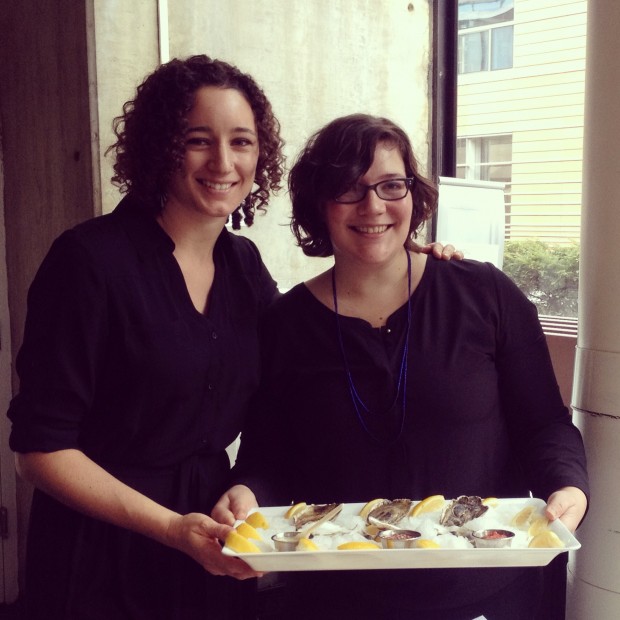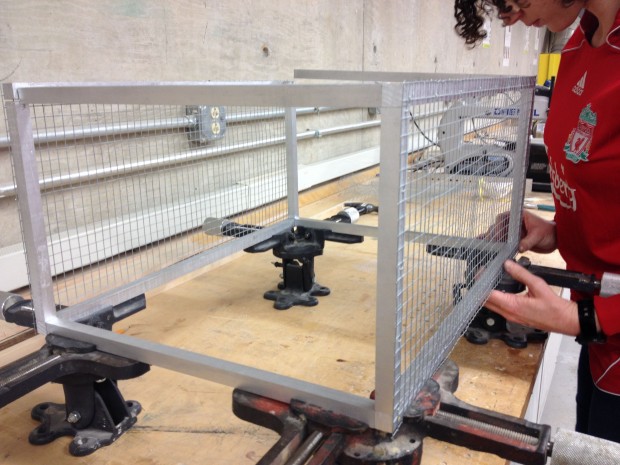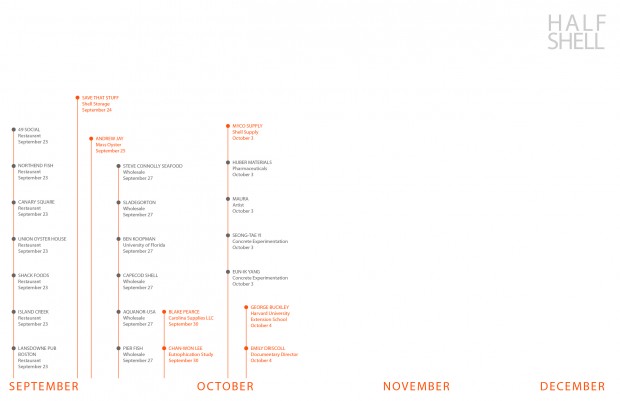Networked Urbanism
design thinking initiatives for a better urban life
apps awareness bahrain bike climate culture Death design digital donations economy education energy extreme Extreme climate funerals georeference GSD Harvard interaction Krystelle mapping market middle east mobility Network networkedurbanism nurra nurraempathy placemaking Public public space resources Responsivedesign social social market Space time time management ucjc visitor void waste water Ziyi
Posts by Murphy, Kelly
We brought Boston’s Oyster Culture in the form of oysters on the half-shell to our critics during our final review.
Our review preparation was different this semester. Instead of perfecting boards and touching-up renderings, Jenny and I shredded horseradish and minced shallots for some classic oyster sauces. A half-hour before we presented, we shucked 22 oysters to serve.
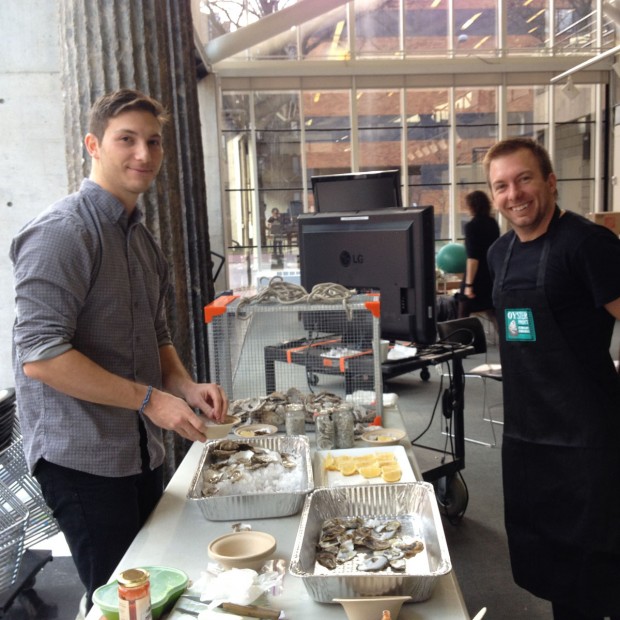
Deniz Bertuna and Chris Johnson help us with preparations for serving oysters on the half shell to critics.
Aquaplot by Jenny Corlett + Kelly Murphy
Aquaplot uses discarded oyster shells from local restaurants to sustain oyster reefs and a re-establish a healthy harbor ecosystem by establishing a city-wide oyster gardening program that closes the oyster waste stream, restores native oyster reefs, improves local water quality, and reconnects the people of Boston with their waterfront.
We presented our proposal at our final review at the Harvard Graduate School of Design. During the review, we brought a bit of Boston’s Oyster Culture to the GSD with a live shucking demonstration and tasting session for our critics. This video was shown after our introduction to oysters and the potential use of their wasted shells.
Here’s our project video:
AQUAPLOT: an oyster garden proposal for Boston. from Kelly Murphy on Vimeo.
Aquaplot
Rethinking Boston’s Oyster Culture
To many people, Boston is synonymous with shellfish, especially oysters. Oysters have always been a cornerstone of the New England diet, and were once a mainstay in the Boston harbor. Oyster reefs were a crucial element of the underwater landscape that filtered our estuaries and maintained our harbor as a rich natural resource area. They not only clean water, but also act as shoreline buffers that dissipate wave energy. What’s more, they support critical fisheries by providing habitat for numerous fish and crustacean species. Oyster reefs, however, are now the most severely impacted marine habitat on Earth: over 85% have been lost globally.
In today’s context we hear a lot about oysters, whether it’s their ability to bolster coastlines in the face of climate change, their water filtration capabilities (the average adult oyster can filter 50 gallons of water per day), their potential for remediating eutrophic waters, or the food culture surrounding their consumption. There is, however, an important gap in this discourse: what about the waste associated with their consumption? What happens to oyster shells once they’ve been discarded?
Most people don’t recognize the magnitude of waste associated with discarded oyster shells once they’re consumed. In Massachusetts alone, 4.1 million pounds of oysters were harvested last year. Over 40 restaurants in Boston serve oysters, lending a distinctive identity to our city. Each restaurant generates around 20 pounds of oyster shell per day. Together, this totals over 300,000 pounds of oyster shell per year in Boston alone. Of these 40+ Boston restaurants, only 4 recycle their shells, meaning that 90% of shells are currently landfilled. Why? Because Boston doesn’t yet have a place for its shells.
How do you use discarded shells to sustain oyster reefs and a re-establish a healthy harbor ecosystem? By establishing a city-wide oyster gardening program that can close the gap in the oyster waste stream by creating demand for discarded shells. Oyster gardening can simultaneously restore native oyster reefs, improve local water quality, and reconnect the people of Boston with their waterfront. There are a number of successful precedents for oyster gardening programs around the region. There is no reason why Boston shouldn’t be at the forefront of oyster gardening given its rich heritage.
Oysters are relevant to the economy of the city and represent a local heritage that people are extremely proud of. While Boston is known for its shellfish, however, it is not performing well on the shell recycling front. Within this broken cycle lies an opportunity for the Boston to address two key problems: wasted shells and oyster reef decline. While there are numerous productive uses for discarded oyster shell, the best use by far is as reef substrate to grow juvenile oysters. The link between the two problems presents an exciting opportunity to propose a better system.
The waters of the Boston Harbor are currently closed to shell fishing due to the risk of oysters being harvested illegally in polluted waters. However, nursery areas for shellfish seeding projects are permitted if they are transplanted to approved waters. Over the last three years, the Massachusetts Oyster Project has proven that oysters can survive in Boston Harbor. In just a few years, oyster gardeners could use discarded restaurant shells to grow thousands of oysters in the Boston Harbor and re-stock endangered reefs in the region.
The benefits of oyster gardening are manifold, and span environmental, economic, and social realms. Oyster gardening connects the waste source to the solution, revives Boston’s local heritage, reconnects people with their waterfront, and brings life back to Boston Harbor.
Here’s our presentation:
AQUAPLOT | Final Presentation by networkedurbanism
Aquaplot by Jenny Corlett + Kelly Murphy
This week, we constructed an Aquaplot Oyster Garden to take to the Boston Harbor.
Aquaplot by Jenny Corlett + Kelly Murphy
Recently, we sent out an email blast to get the word out about our proposal. Recipients included news agencies, state and local government agencies, and environmental organizations. We were encouraged by enthusiastic responses as we continue to make new network connections. This is a fantastic learning process for us, and we’re excited to be part of the close-knit oyster family of Boston.
Here’s the video:
Oyster Gardens for a Healthy Harbor: Rethinking Boston’s Oyster Culture from Kelly Murphy on Vimeo.
Here’s an excerpt of the email blurb:
To many people, Boston is synonymous with shellfish, especially oysters. Most people, however, don’t recognize the magnitude of waste associated with discarded oyster shells once they are consumed. Currently the vast majority are landfilled. Why? Because Boston doesn’t yet have a place for its shells. There are far better places for shells than overflowing landfills – the best being oyster reefs. Oyster reefs are not a new concept for Boston. Reefs were once a naturally occurring part of the underwater landscape, and oysters were a keystone species that filtered our estuaries and maintained our harbor as a rich natural resource area.
How do you use discarded shells to sustain oyster reefs and a re-establish a healthy harbor ecosystem? Through a city-wide oyster gardening program that closes the oyster waste stream, restores native oyster reefs, improves local water quality, and reconnects the people of Boston with their waterfront.
There are a number of successful precedents for oyster gardening programs around the region. We think Boston should be at the forefront of oyster gardening for oyster reef restoration given its rich heritage.
Aquaplot by Jenny Corlett + Kelly Murphy
Aquaplot_Research.pdf by networkedurbanism
Aquaplot by Jenny Corlett + Kelly Murphy
Aquaplot by Jenny Corlett + Kelly Murphy
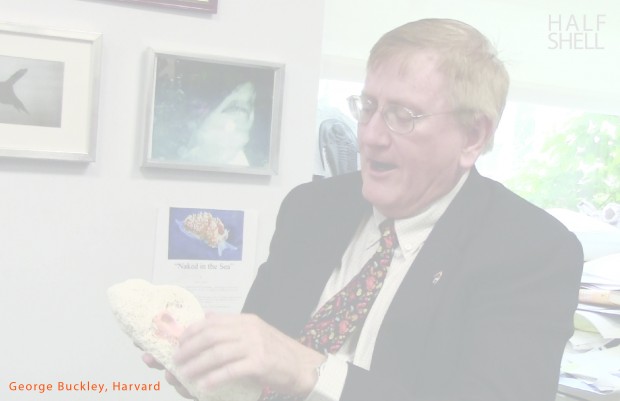
Assistant Director of the Sustainability and Environmental Management Program, Harvard Extension School
Aquaplot by Jenny Corlett + Kelly Murphy
Murphy, Kelly
It appears that Murphy, Kelly hasn't tweeted anything yet.
